Forget buying expensive, high-tech toys for your kids.
Take a note from the Reggio Emilia philosophy and encourage your child’s creativity, problem solving skills and fine motor development with everyday objects and collections.
What are loose parts?
Loose parts are exactly what they sound like – a collection of loose materials or objects for kids to play with however they see fit – explore, sort, build, play pretend and create masterpieces.
Instead of traditional toys that serve a particular function – or cater to a particular gender – loose parts allow children to be limited only by their imaginations.
By playing with different peers (of varying personalities and ages), children learn a whole new perspective on how to use an object.
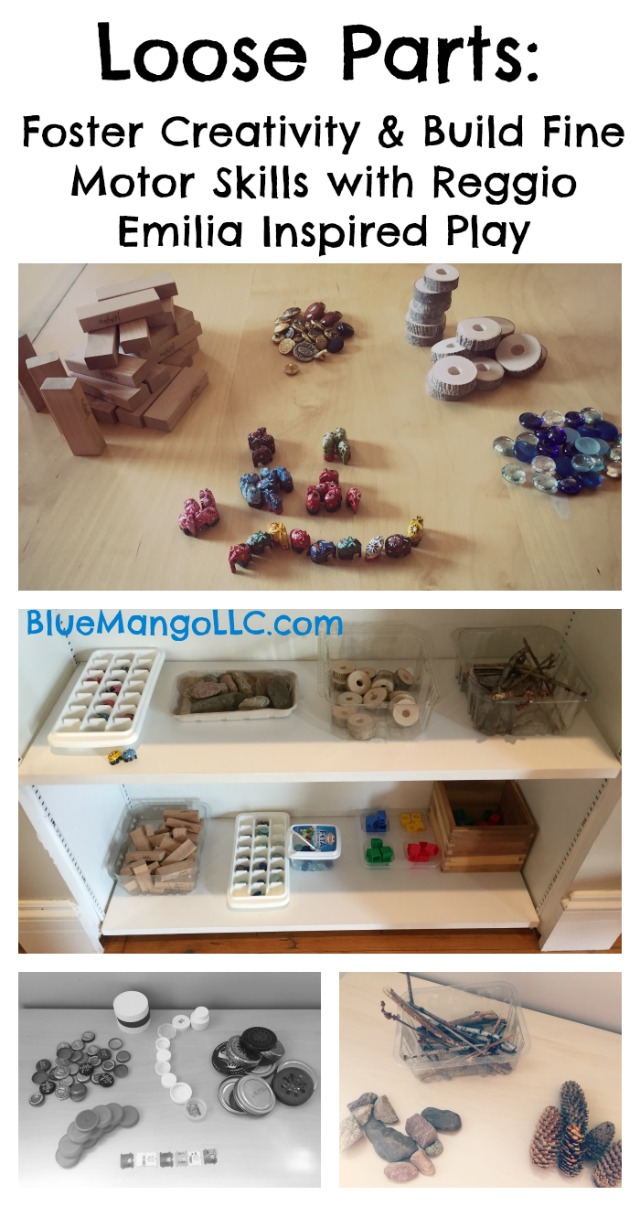
Loose parts are important for learning & play
I think great teaching is a balance between letting kids explore, manipulate, tinker and create through self-directed play and providing them with direct instruction and strategies to master specific skills – for example, while you can set up a literacy rich environment, learning to read is a skill that MUST be taught.
The younger the child, the more important it is for him or her to have this open-ended, unstructured play – children will master the necessary skills if you provide them with the right tools, environment and time.
But this doesn’t mean sit back and do nothing as an adult. We are there to set up the environment, provide materials, spark their interests and ultimately facilitate their learning.
We can get kids to ask questions and help them to accomplish things with just the right amount of support to get them to the next level of mastery (I am a big fan of Lev Vygotsky’s Zone of Proximal Development – but more on that another day!)
One of the best ways to do this is through loose parts play. Loose parts enable kids to direct their own play.
By exploring the properties of objects and deciding what they will be and how they will function, kids work on a wide variety of skills essential for their development:
- creativity
- imagination
- fine motor skills
- visual spacial skills
- engineering & physics
- problem solving
- dramatic play
- symbolic play
- having one thing represent another is an early literacy skill!
Are you ready to add loose parts to your classroom or playroom?
Start your collection of loose parts
The most important thing in loose parts play is beginning to establish your collection of loose parts.
Anything in a large enough quantity looks amazing. My daughter dumped out a whole box of pens the other day and I couldn’t tear her away from them!
So recently I’ve just started collecting anything that might be interesting and am waiting until I have a large enough quantity to set these things out as toys.
First, I try to collect a lot of things from nature – these items are aesthetically pleasing and help children establish a connection with the natural environment.
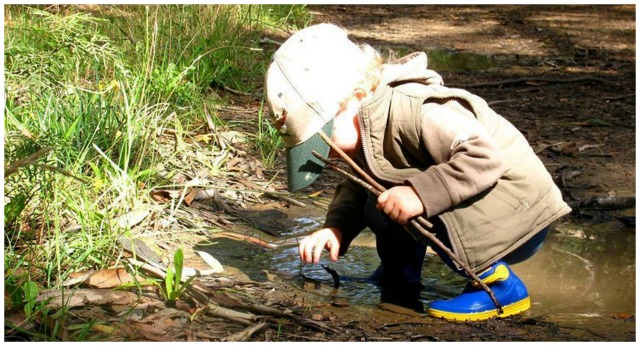
Second, I try to look for a variety of materials and textures in neutral or natural tones such as wood, metal, glass and fabric. Children have plenty of exposure to brightly colored plastic – it’s important for them to learn and experiment with the properties of other materials as well.

But lastly, anything in a big collection is neat. Your collection of loose parts is only limited by your imagination – until they started growing fungus, I had out old potatoes with spuds! Also, don’t forget to take the lead from your kids if they show an interest in something.
Once you have your loose parts, kids can sort and organize them, play with them, or make art with them. Recycled materials are perfect for art projects.
Where can you get your loose parts? Find them in nature, collect them or buy them – bargain stores, craft stores, yard sales and hardware stores are all good places to look.
The following are some great ideas for things to add to your loose parts collection. These are only a few suggestions. If you’re interested in more, I’m constantly pinning new ideas to my Reggio Emilia Inspired Play board.
Collect items from nature
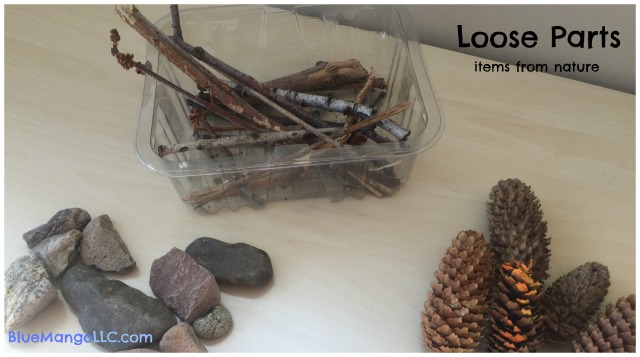
- sticks
- pinecones
- rocks
- seashells
- sea glass
- acorns
- bark
Buy/collect small objects in large quantities
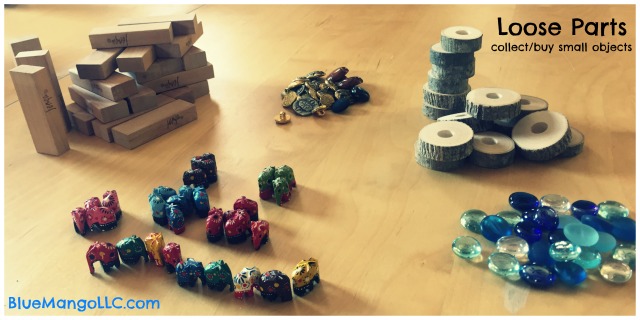
- buttons
- colorful stones
- real tile (bathroom, kitchen, etc.)
- washers, nuts & bolts
- wooden dowels
- pipe cleaners
- pom poms
- fake flowers
- keys
- uncooked pasta
- napkin rings
- fabric squares or scarves
- small or large beads (great for threading onto dowels, pipe cleaners or string)
- wooden blocks (craft store, toy store, DIY – hardware store or nature, Jenga)
Collect recycled materials
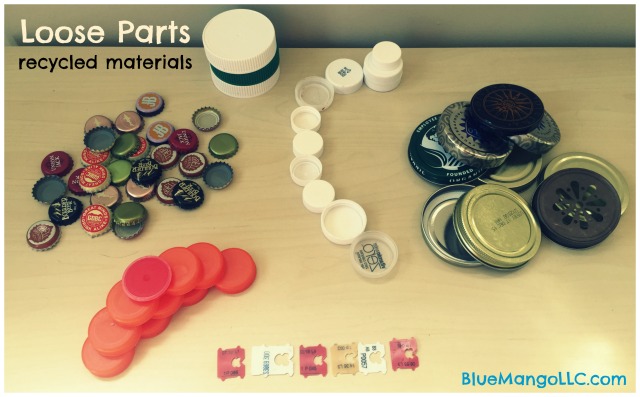
- corks
- bread tabs
- peanut butter & salsa tops
- paper towel & toiler paper rolls
- bottle caps – beer, milk & other bottled drinks
A reminder about choking
I was so excited that my daughter was starting to incorporate loose parts into her play that I forgot about choking. She is almost 2 and getting out of the mouthing phase so I trusted her more than I should have.
However, after several weeks of sorting and exploring buttons left on a shelf in the kitchen, I caught her stuffing them in her mouth!
I was cooking dinner and so proud of her independent play and engagement in these junk collections I so thoughtfully put together for her – I forgot I had a toddler. We talked about how buttons were not for eating and she lost the privilege of playing with them for that day.
But alas the other day I also caught her eating chalk! Be wary of the toddler engaged in independent play.
I strongly recommend that you don’t use small loose parts for children under 3 (objects shouldn’t be able to pass through a toilet paper roll), keep your older child’s small toys out of reach and always supervise your children.
How to set up the environment for loose parts play
Just having jumbled mass of loose parts is not enough. An important piece of the early childhood learning environment is how you organize materials and set up the space to encourage the type of play you are looking for – and draw in and excite children into the process.
Here are some ways to set up the right environment for your loose parts play.
Empty containers
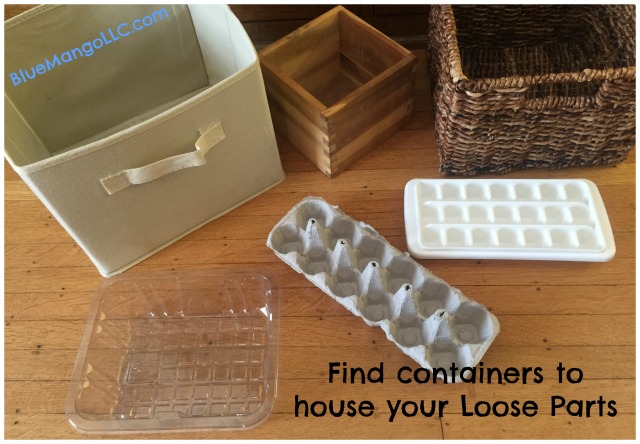
You will want a variety of containers sized appropriately for the materials in them. While I love natural containers – wooden boxes, wicker baskets, canvas cubes – it’s easy to collect containers around the house.
We go through a box of lettuce each week and these clear plastic containers have been the perfect size for many of our loose parts.
Containers with multiple compartments are also great. These help you to group certain items together and allow kids to sort materials. Again you can buy these or use things around the house such as recycled egg cartons and spare ice cube trays or silverware holders.
Child level shelves
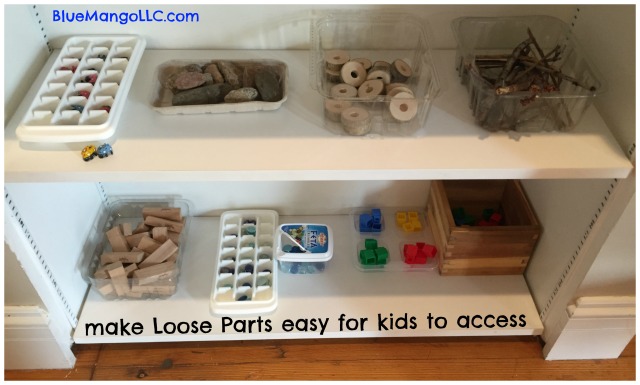
Because working with loose parts is child-directed, not teacher-directed, children should have easy access to a variety of materials to take out as they see fit.
While pre-planned, whole group lessons have their place in the classroom, loose parts play allows for creativity and open-ended exploration. Just by setting up an appealing environment, you can encourage kids to get excited about self-directing their own play.
Develop a method for organizing – by color, function (building, pretend play, art), theme – and then invitingly display your items in a way that allows kids to easy take items off the shelf and place them back neatly.
Table (or space) to work at
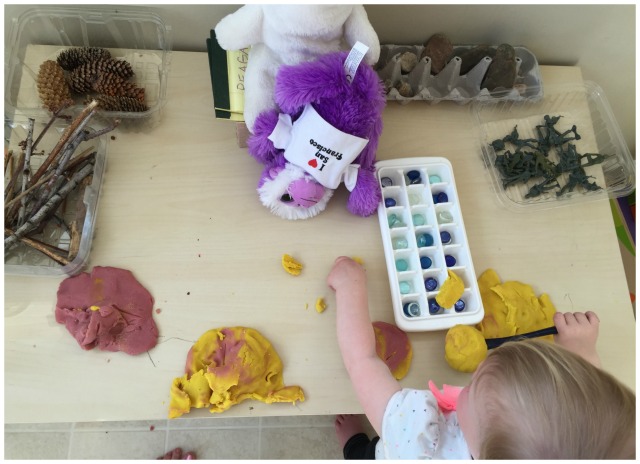
It’s important for children to have a workspace where they can use their loose parts. It’s helpful for children to have a variety of appealing locations where they can use their items as they see fit.
Children might want to work standing at a table, sitting at a table (stools and a counter are always fun), sitting or laying on the rug.
Don’t forget loose parts are also important for outdoor play! While children will naturally find the best workspace for their loose parts outside, you can make sure they have a variety of options like concrete, grass, sand/dirt, and even some natural tables and chairs.
Another fun way to spice up a workspace is to add a mirror. Place one flat on a table or standing to help kids understand patterns and symmetry.
Storage area to rotate out materials
One of the best strategies I’ve learned as a teacher is to rotate items. It keeps things exciting and new and creates a low stress environment for kids. When there are toys everywhere – and there are too many choice – kids get overwhelmed.
In addition, in a messy, overcrowded play space kids tend not to take care of materials properly and don’t play meaningfully – they just dump everything out and make a big mess. Make sure everything has a place and is clearly labeled.
Labeling items is also a fantastic way to add environmental print – important for early literacy development – to your play space!
Share your Pinterest ideas!
I’m always looking for more ideas – what’s in your loose parts collection?
Leave a link to your favorite Loose Parts pin in the comments below!
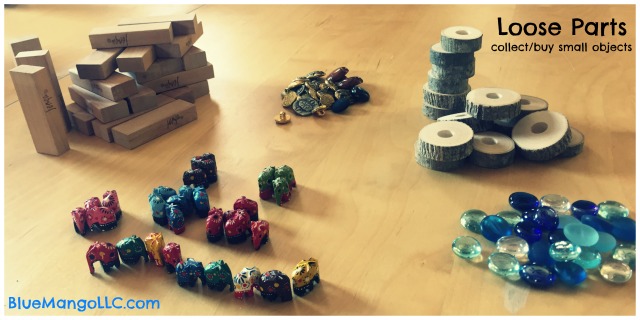
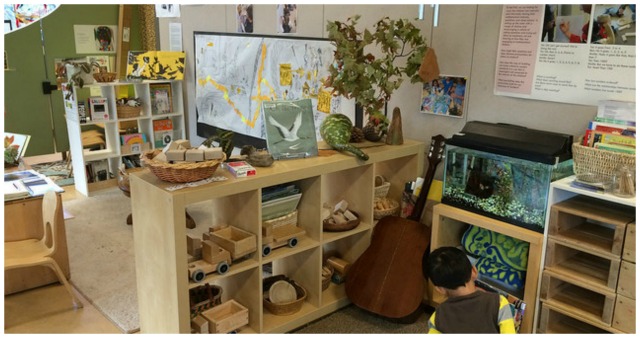
Great article and a joy to read! I love incorporating loose parts into my Reggio inspired program. Just one correction. Lev Vigotsky, not Zygotsky.
I have added a short video clip of a 3-4 year old class deeply engaged in loose parts play with clay. You can watch it here . Loose parts learning has been trending in classrooms other than Reggio. Natural material are a great way to connect children with the outdoors.